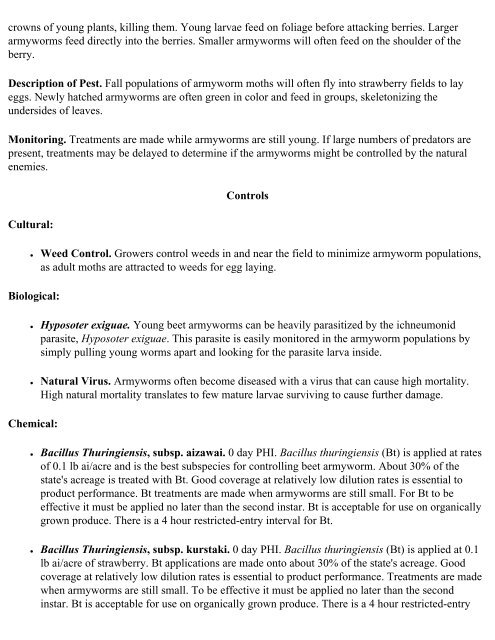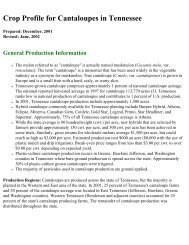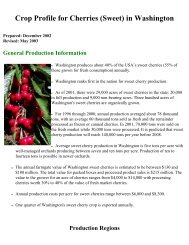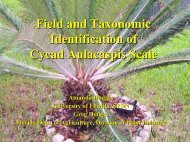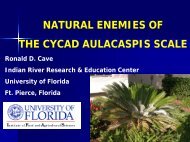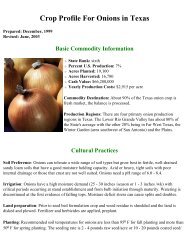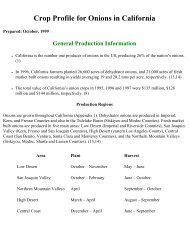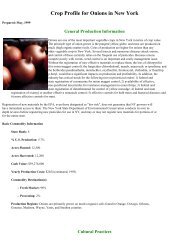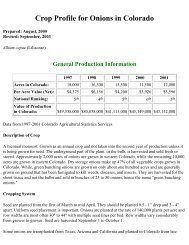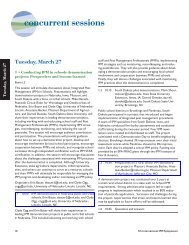Crop Profile for Strawberries in California - Regional IPM Centers
Crop Profile for Strawberries in California - Regional IPM Centers
Crop Profile for Strawberries in California - Regional IPM Centers
You also want an ePaper? Increase the reach of your titles
YUMPU automatically turns print PDFs into web optimized ePapers that Google loves.
crowns of young plants, kill<strong>in</strong>g them. Young larvae feed on foliage be<strong>for</strong>e attack<strong>in</strong>g berries. Larger<br />
armyworms feed directly <strong>in</strong>to the berries. Smaller armyworms will often feed on the shoulder of the<br />
berry.<br />
Description of Pest. Fall populations of armyworm moths will often fly <strong>in</strong>to strawberry fields to lay<br />
eggs. Newly hatched armyworms are often green <strong>in</strong> color and feed <strong>in</strong> groups, skeletoniz<strong>in</strong>g the<br />
undersides of leaves.<br />
Monitor<strong>in</strong>g. Treatments are made while armyworms are still young. If large numbers of predators are<br />
present, treatments may be delayed to determ<strong>in</strong>e if the armyworms might be controlled by the natural<br />
enemies.<br />
Cultural:<br />
Controls<br />
● Weed Control. Growers control weeds <strong>in</strong> and near the field to m<strong>in</strong>imize armyworm populations,<br />
as adult moths are attracted to weeds <strong>for</strong> egg lay<strong>in</strong>g.<br />
Biological:<br />
● Hyposoter exiguae. Young beet armyworms can be heavily parasitized by the ichneumonid<br />
parasite, Hyposoter exiguae. This parasite is easily monitored <strong>in</strong> the armyworm populations by<br />
simply pull<strong>in</strong>g young worms apart and look<strong>in</strong>g <strong>for</strong> the parasite larva <strong>in</strong>side.<br />
● Natural Virus. Armyworms often become diseased with a virus that can cause high mortality.<br />
High natural mortality translates to few mature larvae surviv<strong>in</strong>g to cause further damage.<br />
Chemical:<br />
● Bacillus Thur<strong>in</strong>giensis, subsp. aizawai. 0 day PHI. Bacillus thur<strong>in</strong>giensis (Bt) is applied at rates<br />
of 0.1 lb ai/acre and is the best subspecies <strong>for</strong> controll<strong>in</strong>g beet armyworm. About 30% of the<br />
state's acreage is treated with Bt. Good coverage at relatively low dilution rates is essential to<br />
product per<strong>for</strong>mance. Bt treatments are made when armyworms are still small. For Bt to be<br />
effective it must be applied no later than the second <strong>in</strong>star. Bt is acceptable <strong>for</strong> use on organically<br />
grown produce. There is a 4 hour restricted-entry <strong>in</strong>terval <strong>for</strong> Bt.<br />
● Bacillus Thur<strong>in</strong>giensis, subsp. kurstaki. 0 day PHI. Bacillus thur<strong>in</strong>giensis (Bt) is applied at 0.1<br />
lb ai/acre of strawberry. Bt applications are made onto about 30% of the state's acreage. Good<br />
coverage at relatively low dilution rates is essential to product per<strong>for</strong>mance. Treatments are made<br />
when armyworms are still small. To be effective it must be applied no later than the second<br />
<strong>in</strong>star. Bt is acceptable <strong>for</strong> use on organically grown produce. There is a 4 hour restricted-entry


